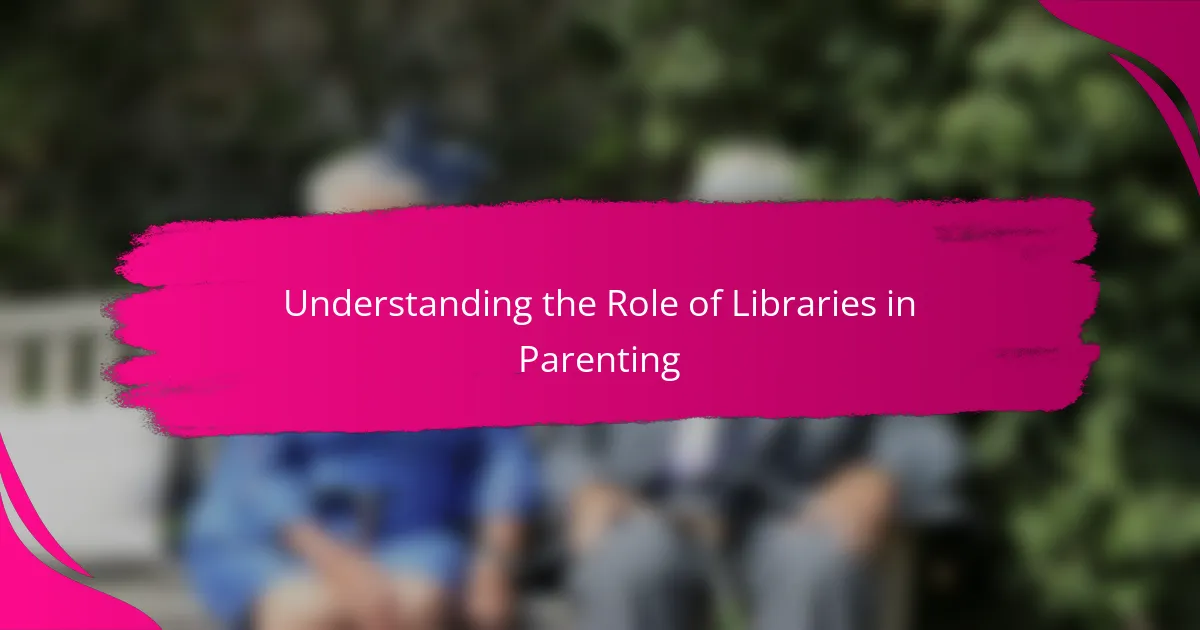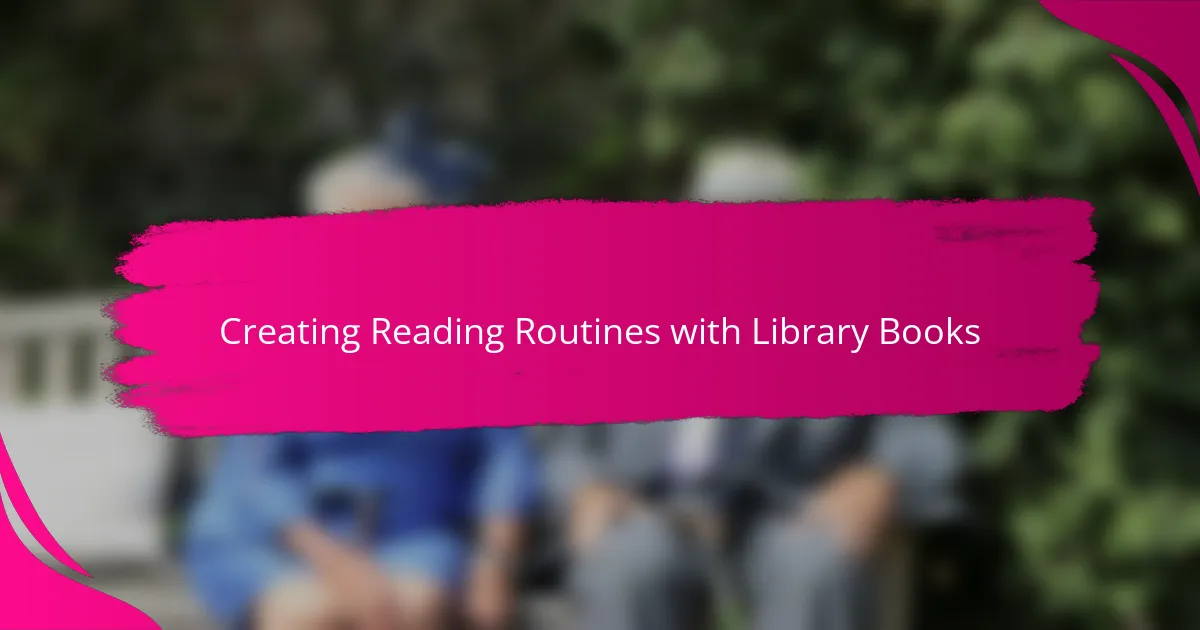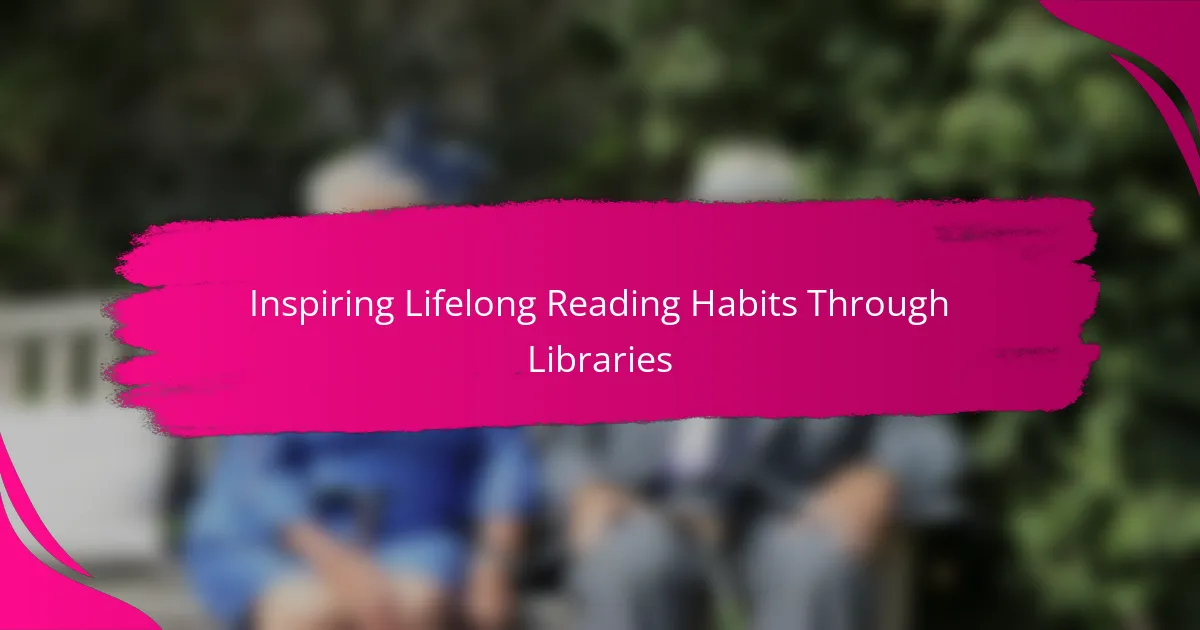Key takeaways
- Libraries serve as community hubs for parents and children, fostering a love for reading through interactive programs and storytime sessions.
- Encouraging reading at home cultivates patience, focus, and empathy, while providing a comforting routine that strengthens parent-child bonds.
- Libraries support literacy by offering diverse resources and programs that make reading engaging and accessible for all children.
- Creating a reading routine that involves children in book selection encourages independence and enthusiasm for lifelong learning.

Understanding the Role of Libraries in Parenting
When I first took my child to our local library, I didn’t realize how much more it would become than just a place to borrow books. Libraries serve as community hubs where curiosity is sparked and imagination is nurtured, making them invaluable allies in parenting. Have you noticed how a simple visit can transform a child’s attitude towards learning?
In my experience, libraries offer parents a wealth of support beyond just books. Storytime sessions and interactive programs create a shared experience, allowing me to connect with my child while fostering their love for reading. It’s moments like these that remind me why libraries are essential in cultivating not just literacy, but meaningful parent-child bonds.
What makes libraries truly special is the sense of inclusion and access they provide, regardless of background or resources. I often reflect on how this accessibility enriches our family’s life, giving my child opportunities to explore new worlds and ideas without barriers. Isn’t that the kind of support every parent hopes to find?

Benefits of Encouraging Reading at Home
Encouraging reading at home has transformed the way my child approaches the world. I’ve seen how those quiet moments with a book build patience, focus, and empathy—qualities that no screen time could easily replace. Don’t you find it amazing how a simple story can open up a child’s mind in ways that last a lifetime?
There’s also something deeply comforting about reading together in our cozy corner. It’s not just about learning words; it’s about sharing emotions, sparking imagination, and creating memories. I often catch myself cherishing those bonding times, knowing they strengthen our relationship beyond the pages.
Plus, reading at home fosters independence and confidence. Watching my child choose books that interest them and explore at their own pace is rewarding. Have you noticed how this quiet encouragement can build a lifelong love for learning? It’s a priceless benefit I wouldn’t trade.

How Libraries Support Child Literacy
Libraries have been a cornerstone in supporting my child’s literacy journey by offering more than just books—they provide a rich environment where reading becomes an adventure. I remember how the colorful displays and cozy reading nooks captured my child’s attention, turning what could be a chore into genuine excitement about stories. Isn’t it incredible how the right setting can make such a difference in a child’s eagerness to read?
Another way libraries support literacy is through their diverse programs tailored to different age groups and interests. Whether it’s a puppet show that brings a story to life or a book club where kids discuss characters and ideas, these experiences deepen understanding and make literacy feel alive. From my experience, these activities help children connect with reading on a personal level, making the process fun and meaningful.
What stands out most to me is how libraries remove barriers that might otherwise limit a child’s access to books and learning resources. No matter our background or schedule, the library is always there, offering free access to knowledge and encouraging exploration. Have you noticed how having that open door creates a sense of encouragement and possibility for your child? For me, it’s been a reassuring constant in nurturing a lifelong love of reading.

Selecting Age-Appropriate Library Resources
Choosing the right books for my child at the library has always felt like a small adventure in itself. I’ve learned to pay attention to the themes and language that match her age and interests, which keeps her engaged without feeling overwhelmed. Have you noticed how children light up when they find stories that truly speak to where they are in their world?
Sometimes, I rely on the library staff’s recommendations because they understand age-appropriate materials better than anyone. Their guidance has saved me from picking books that were either too simple or too advanced, making our reading time more enjoyable and productive. Isn’t it reassuring to have experts help steer the way?
What really matters is giving kids the space to explore at their own pace, so I make sure to mix familiar favourites with new discoveries suitable for their developmental stage. Watching my child confidently choose books that challenge her just enough is one of the most rewarding parts of our library visits. How often do you get to see growth so clearly through something as simple as picking a book?

Strategies for Visiting Libraries with Children
One thing I always do when taking my child to the library is plan our visits around storytime or special events. These moments naturally grab her attention and make the experience feel like a fun outing rather than a chore. Have you ever noticed how a lively storyteller or a puppet show can turn a quiet library into a magical place for kids?
I also make it a point to let my child lead the way once we arrive. Giving her the freedom to choose books or explore different sections sparks her curiosity and ownership over reading. Sometimes, that means sitting on the floor flipping through picture books or wandering toward the crafts table—either way, it’s her choice, and that makes all the difference.
To keep visits stress-free, I keep our trips short and sweet, especially with younger kids who might tire quickly. I find that a quick, positive interaction encourages them to look forward to the next visit instead of feeling overwhelmed. How often do we forget that a happy, relaxed experience is the best way to build lasting reading habits?

Creating Reading Routines with Library Books
When I started setting a regular reading routine with library books, it quickly became a comforting ritual for both of us. Every evening, we’d settle into our favorite spot at home with the books we’d picked that day, turning what could feel like a task into something we both genuinely looked forward to. Have you ever noticed how having a specific time for reading helps build excitement and consistency, even on busy days?
One trick I found helpful was involving my child in choosing the books during our library visits. This way, the routine didn’t feel forced but rather a natural extension of their interests. Seeing their face light up when they find a new favorite story makes those quiet reading moments feel like a shared adventure, reinforcing our bond more than I expected.
Sometimes, we mix up our routine by reading aloud or acting out parts of the story, turning library books into interactive experiences. It’s amazing how this approach keeps reading lively and encourages my child to engage deeply with the material. What small changes have you tried to keep your reading routine fresh and enjoyable? For me, these little shifts have made all the difference.

Inspiring Lifelong Reading Habits Through Libraries
There’s something truly magical about watching my child get lost in a library book, as if the stories are whispering directly to their curious mind. I’ve noticed that the variety and richness of library collections invite children to explore topics far beyond their everyday experiences, planting seeds for a lifelong passion in reading. Doesn’t it amaze you how a single library visit can ignite a child’s imagination in ways that last a lifetime?
I’ve often reflected on how consistent trips to the library create rituals that encourage not just reading, but a genuine love for learning. When my child picks out books that excite them, I see their confidence grow alongside their vocabulary and understanding. Have you ever experienced the thrill of your child proudly sharing a new story they discovered at the library? Those moments feel like milestones on the path of lifelong literacy.
What strikes me most is how libraries empower children to become independent readers, giving them the freedom to choose what captures their heart and mind. That sense of autonomy fuels enthusiasm, making reading feel less like a task and more like a personal adventure. Isn’t that exactly the kind of habit we want to nurture — one that stays with our kids long after they’ve grown?
